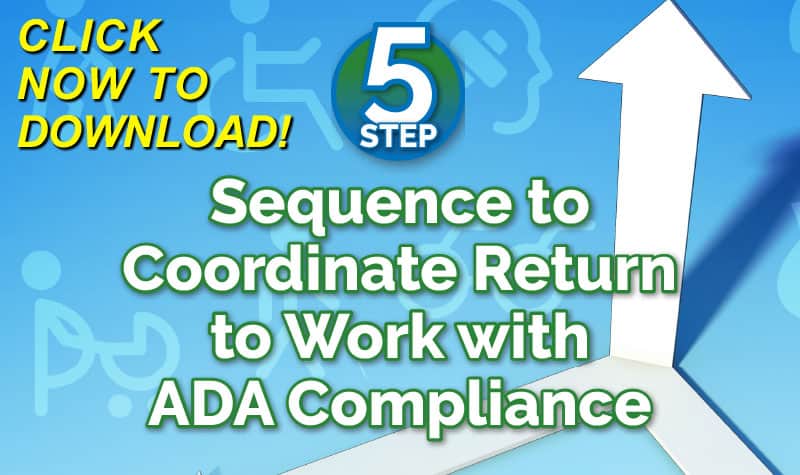Companies are always seeking innovative ideas to reduce the cost of their workers’ compensation program. One idea that is driving these efforts is the use of baseline testing of prospective employees.
Click Link to Access Free PDF Download
“5-Step Sequence to Coordinate Return-to-Work with ADA Compliance”
What is “Baseline Testing”
Baseline or “bookend” testing is the use of various medical and diagnostic testing in the hiring phase of new employees to develop a profile to measure subsequent workplace exposure and assist future claim investigations. Under this process, prospective candidates are required to undergo medical tests such as electromyography (EMG), and various functional assessments. The rationale for this process is to use those initial results as a “baseline” and compare them to post-injury findings. This allows claim professionals to make more accurate primary liability determinations and for use by medical experts when conducting an independent medical examinations.
Legal Problems Associated with Baseline Testing
One of the obvious issues associated with this trend are state and federal anti-discrimination and hiring practice laws. It also raises legal concerns about the limiting employment opportunities for persons with pre-existing medical conditions and their ability to seek and obtain gainful employment. There are also numerous legal obstacles for using such tests with existing employees. Before implementing a baseline-testing program, every program administrator should seek legal advice and understand the ramifications of such programs.
The Pros and Cons of Baseline Testing
The increasing use of baseline testing in workers’ compensation cases has called the concept into question when identifying most soft issue-type injuries and repetitive use/motion claims.
In support of using these tests, proponents argue that the medical evidence speaks for itself. This is especially true when it is conducted by an independent doctor or specialist who does not release the results until after an injury claim is made. It is also noted that it is impossible to change or alter the results of objective medical evidence such as film from an x-ray, MRI or other scans.
On the other hand, it is noted that objective medical evidence also needs to be substantiated by subjective complaints. This is often the case in disc herniation cases where the subjective complaints of a worker need to be considered in conjunction with objective medical findings.
Putting Baseline Testing to Use
In order to comply with the Americans with Disabilities Act (ADA), employers need to be careful how baseline testing is used in their hiring process. For example, conflict may arise if certain questions regarding workability are asked prior to the issuance of a conditional job offer. There are also limits on what questions can be asked at any time during the hiring process, but generally it is permissible to inquire about the following:
- The applicant’s ability to engage in certain job functions;
- Inquiry about the prospective employee’s skills and non-medical qualifications; and
- The applicant’s knowledge of certain job functions.
The ADA also allows employers to generally do the following prior to making that candidate an employee:
- Require applicants to undergo a job-related physical ability test;
- Provide documentation in the form of medical certification that they are able to perform the essential functions of a position;
- Testing for illegal use of controlled substances; and
- Require the prospective employee to assume liability for any injuries resulting from physical testing.
It is also important to be aware of state law concerning these issues and make sure all aspects of the process comply.
Conclusions
Workers’ compensation program administrators should consider baseline testing as part of their cost-control process. When doing so, it is important to know the applicable laws and apply them to your hiring and post-injury investigation processes.
Author Michael Stack, Principal of Amaxx Risk Solutions, Inc. He is an expert in employer communication systems and helps employers reduce their workers comp costs by 20% to 50%. He resides in the Boston area and works as a Qualified Loss Management Program provider working with high experience modification factor companies in the Massachusetts State Risk Pool. As the senior editor of Amaxx’s publishing division, Michael is on the cutting edge of innovation and thought leadership in workers compensation cost containment. http://reduceyourworkerscomp.com/about/. Contact: mstack@reduceyourworkerscomp.com.
©2015 Amaxx Risk Solutions, Inc. All rights reserved under International Copyright Law.
SALES TO PAY FOR ACCIDENTS CALCULATOR: http://reduceyourworkerscomp.com/sales-to-pay-for-accidents-calculator/
MODIFIED DUTY CALCULATOR: http://reduceyourworkerscomp.com/transitional-duty-cost-calculators/
WC GROUP: http://www.linkedin.com/groups?homeNewMember=&gid=1922050/
SUBSCRIBE: Workers Comp Resource Center Newsletter
Do not use this information without independent verification. All state laws vary. You should consult with your insurance broker, attorney, or qualified professional.



